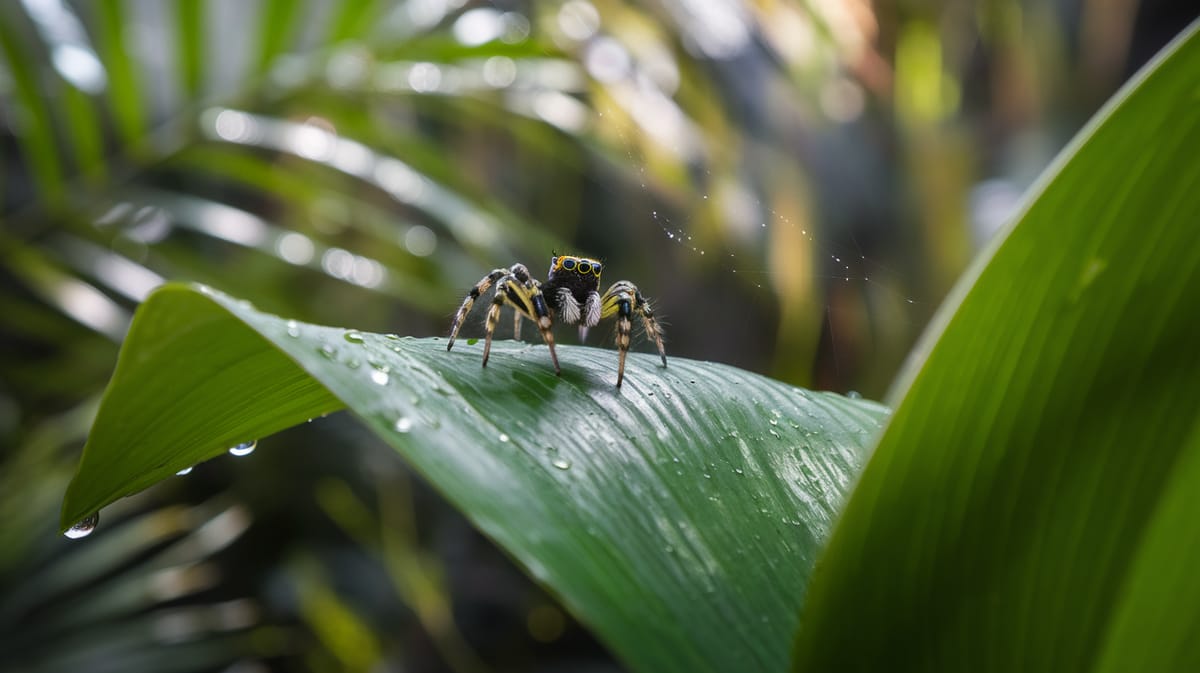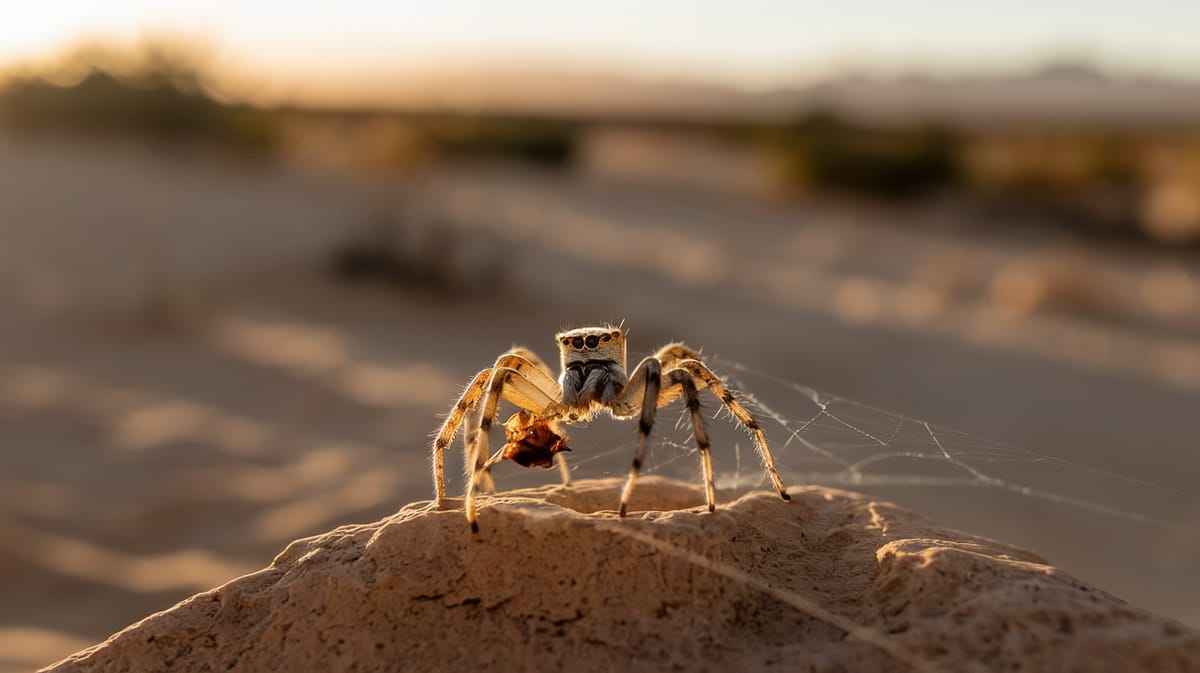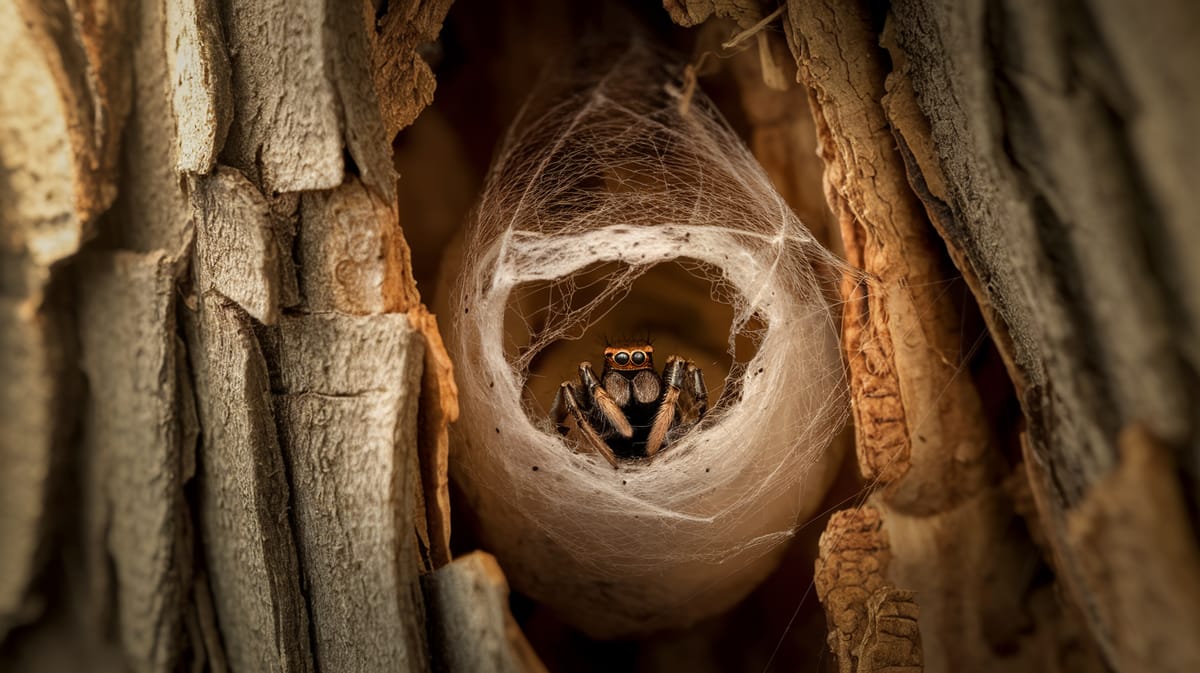Jumping Spider
With keen eyesight and agile leaps, the jumping spider thrives as a skilled predator, playing a vital role in pest control. Its colorful patterns and curious behavior captivate observers.

Key Insights at a Glance
Did You Know?
Taxonomy & Classification
Jumping spiders, known for their extraordinary vision and agile hunting skills, are masterful predators with intricate courtship displays and vibrant coloration. Let's understand the evolutionary journey and classification of these remarkable predators.
Species Diversity
With over 6,000 species in the Salticidae family, jumping spiders exhibit incredible adaptability and widespread distribution across various ecosystems.
Evolutionary Adaptations
Originating around 50 million years ago, jumping spiders developed advanced vision and leaping abilities, aiding their survival and predatory success.
Lifecycle and Growth
A remarkable journey of transformation from Egg to Adult.
Egg
Eggs are laid in silk sacs, providing protection and stable humidity until spiderlings emerge.
Spiderling
Spiderlings resemble tiny adults and undergo multiple molts, gradually developing their distinctive jumping abilities.
Adult
Adults exhibit vibrant colors and complex courtship dances, crucial for mating success and territorial behavior.
Dietary Habits
A skilled predator with keen vision, this insect captures prey using intricate stalking and leaping methods, adapting to varied diets.
| DIET TYPE | DESCRIPTION |
|---|---|
| Primary Diet | Feeds mainly on ants, flies, and other small insects, utilizing excellent vision and precise jumps for capture. |
| Secondary Diet | Occasionally eats nectar and pollen, supplementing its diet with plant-based food in certain environments. |
| Occasional | Rarely consumes small arthropods or other opportunistic prey when typical food sources are scarce. |

Behaviour and Adaptations
Discover the remarkable capabilities that make the Jumping Spider a masterful predator in its environment.
Incredible Vision
Eight eyes provide sharp vision, crucial for precise hunting and navigation.
Leap Mastery
Executes jumps up to 50 times its body length, aiding in surprise attacks and escape.
Silk Safety Lines
Spins silk lines as a safety tether during jumps, preventing falls and aiding navigation.
Ecosystem Impact
Jumping Spiders play critical roles in maintaining ecosystem health and stability.
Natural Pest Controller
Helps manage insect populations by preying on flies, mosquitoes, and other pests.
Biodiversity Promoter
Supports diverse ecosystems by being both predator and prey.
Pollination Helper
Assists in pollination by visiting flowers for nectar.
Conservation Challenges
Addressing the major threats to Jumping Spider populations.
Habitat Loss
Urban development and deforestation reduce natural habitats for jumping spiders.
Pesticide Exposure
Chemical pesticides harm jumping spider populations and reduce prey availability.
Climate Change
Altering climates affect habitat suitability and prey abundance for jumping spiders.
Frequently Asked Questions
How long do Jumping Spider live?
Jumping spiders typically live for about one year, although some may survive up to two years in favorable conditions. Their lifespan varies based on factors like species, climate, and predator presence. They experience different life stages, including egg, juvenile, and adult before reaching maturity.
What do Jumping Spider eat?
Jumping spiders primarily feed on insects and other small arthropods. They are active hunters, relying on their excellent vision and agility to catch prey. Common food items include flies, moths, and other small insects which they capture using their jumping ability.
Are Jumping Spider poisonous?
Jumping spiders are not considered dangerous to humans. They possess venom to subdue their prey, but it is typically harmless to people. Bites are rare and may cause mild irritation or redness. They are more interested in hunting insects than interacting with humans.
Are Jumping Spider endangered?
Jumping spiders are not generally considered endangered. They are widespread and adaptable, inhabiting various environments worldwide. While habitat loss and environmental changes can impact local populations, many species continue to thrive in both natural and urban areas.
What do Jumping Spider symbolize?
In various cultures, jumping spiders symbolize agility, curiosity, and patience. They are often associated with focus and determination due to their hunting techniques. Some view them as a sign of good luck or protection because of their role in controlling pests.
Do Jumping Spider bite?
Jumping spiders can bite, but incidents are rare and typically not serious. They are more likely to flee than attack when threatened. If bitten, symptoms may include mild pain, redness, or itching. They are not aggressive towards humans and pose little threat.
What color are Jumping Spider?
Jumping spiders come in a variety of colors, including black, brown, gray, and even vibrant hues like red, blue, or green. Their coloration can depend on the species and environment, often serving as camouflage or a means to attract mates.
Does a Jumping Spider have wings?
Jumping spiders do not have wings. They rely on their strong legs and excellent vision to move and hunt. Known for their impressive jumping ability, they can leap several times their body length to catch prey or escape threats.
What does a Jumping Spider look like?
Jumping spiders are small, compact, and hairy with a distinctive eye pattern. They have four pairs of eyes, with the central pair being large and forward-facing, providing excellent binocular vision. Their robust legs aid in their agile movements and impressive jumping abilities.
Is a Jumping Spider an insect?
Jumping spiders are not insects; they are arachnids. They belong to the family Salticidae within the order Araneae. Unlike insects, which have six legs and three body segments, arachnids have eight legs and two main body segments: the cephalothorax and abdomen.
Related Insects
Discover insects with similar characteristics to Jumping Spider - including shared habitats, diets, and taxonomic classifications
Share this profile
Help others discover Jumping Spider
